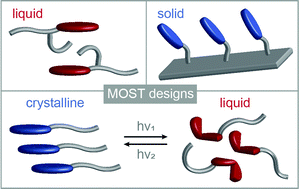Solar energy conversion and storage by photoswitchable organic materials in solution, liquid, solid, and changing phases
Abstract
This review illustrates various structural design principles for molecular solar thermal (MOST) energy storage materials based on photoswitches that operate under different conditions, e.g. solution state, neat liquid, and solid, or result in a solid–liquid phase transition during their photo-isomerization. The structural modifications of MOST compounds enable the formation of each phase, which also influences the important performance metrics of the photoactive energy materials: the energy storage density per molecule or gravimetric energy density. Other major optical and thermal properties are also modulated by the molecular designs and affect the energy storage period, efficiency of the system, and device structures that accommodate the solar energy storage in each form of the MOST compounds. The introduction of different strategies that enable the large density heat storage under specific phase conditions will help to facilitate the further development of efficient MOST systems that will be readily integrated to device-scale applications with a transformative impact on the renewable energy markets.

- This article is part of the themed collection: Journal of Materials Chemistry C Emerging Investigators


 Please wait while we load your content...
Please wait while we load your content...